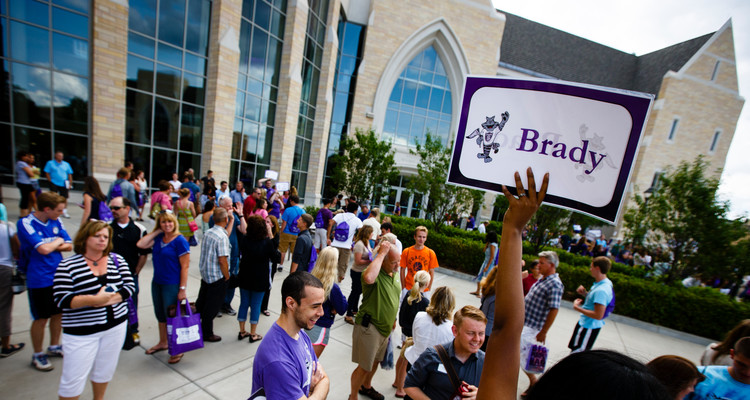It was summer 2013. I agonized over selecting an outfit that would make me look effortlessly cool during my eight-hour first-year orientation. I’m not sure I succeeded on the cool front, but the compliment I received on my signature curls was a win.
What remains of my orientation are vague memories of James B. Woulfe Alumni Hall, lunch in Scooter’s with fellow freshmen I have yet to see again, a miraculous first-semester schedule with no Friday classes and receiving an ID card that, three years later, features a barely recognizable, faded-out face. I also remember some kind of sing-along, thankfully before the days of “Frozen.”
This is normal. After all, Assistant Dean of Students Josh Hengemuhle said students aren’t expected to retain everything they learn in that jam-packed day.
“Students are coming in with a whole lot of different experiences and expectations, but they want their class schedule; they want to meet people,” Hengemuhle said. “Those are the two most important things on their minds that day, and everything beyond that is always going to be work to get them engaged, and even more work to get them to remember.”
The sessions on inclusivity, safety, billing and financial aid, academic expectations, study abroad, career exploration, living on or off campus and the information fair are presented to students as appetizers, ways to whet the appetite for what they will experience as Tommies.
“We can’t just be a fire hose spraying them with information,” Hengemuhle said. “Part of the reason we only do 10 minutes of study abroad is because too much more than that isn’t where they’re thinking at that point in time. There’s a reason we don’t have a lot of content about major selection because they’re a year or two away from that.”
First-year orientation is a foundation, a transition piece into the St. Thomas community.
At first glance, this foundation seems unchanging. Each year students and their families split up to learn relevant information. Each year, these orientation attendees are grateful for the air-conditioned student center. Each year features 12 student orientation leaders teaching similar content.
But no two orientations are ever exactly the same.
For example, before 2009, first-year orientation spanned two days instead of one. And before that, orientation was held right before the school year began – instead of during July. As the strategic plan developed, so has the orientation program content, and this year’s orientations will incorporate the new “all for the common good” theme.
“That’s one of the things I love about orientation: We can try new things,” Hengemuhle said.
St. Thomas has held nine orientation sessions in July over the past several years, and recently added a 10th right before first-year move-in. This extra orientation session is to better accommodate students coming from a distance, and this year, half of the seats are reserved for domestic students. The other half? For first-year international students.
International students have had a separate orientation for as long as Hengemuhle can remember, but will now get the chance to interact with domestic students and even go to the Minnesota State Fair together as an introduction to their new Midwest home.
Hengemuhle is in charge of hiring, training and selecting the staff who work orientation, as well as doing program planning and implementation.
He has a wizard-behind-the-curtain sort of role. “My hope is to do a good job of getting stuff done behind the scenes so that our dean and our vice president and all the other people who do great things around here can really be showcased,” he said.
Other members of Hengemuhle’s behind-the-scenes-team are one graduate assistant, two undergraduate interns and 12 student orientation leaders, all of whom are different every year. These staff members are so valued that they are invited to an annual orientation leader reunion to showcase their work and reminisce with fellow leaders.
This St. Thomas conviction for personal attention is perhaps most present during the academic counseling sessions at orientation. Long ago, according to Hengemuhle, students were walked to computer labs in the science building during the last hour or so of orientation day to register for courses. “But they didn’t know what they were doing; there wasn’t adequate time to explain the process, the core curriculum, etc.” Hengemuhle said. “So now academic advisers create the schedules and have 15-minute meetings with each student, giving the opportunity for one-on-one connection and explaining, ‘this is your schedule and here’s what that means.’”
The work to build those individual schedules for students begins long before the orientation day. Staff in Academic Counseling and Support make up the critical “Registration” portion of the Orientation & Registration program, spending hours upon hours in the summer crafting the details of those individual schedules, so that when the student arrives for their 15 minutes, they have a schedule built specifically for them.
Planning for first-year orientation is a yearlong process, with the programs themselves in July followed by transfer student orientations in August, assessing survey results in September, processing how it went with orientation presenters in October, hiring the orientation team in November and so on.
With about 1,400 incoming freshmen each year and a myriad of moving pieces and people orchestrating orientation, when asked what surprises him every time Hengemuhle joked, “To some degree, that we pull it off!”







